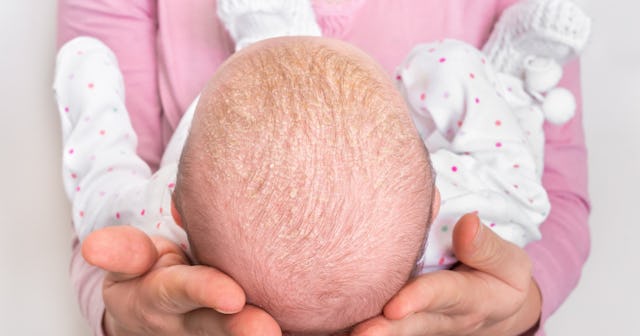Here Are The Causes (And Best Treatments) For Your Baby's Dry Scalp

This article has been medically reviewed by Dr. Rosanna Spear, a partner at Lansdale Pediatrics, a private outpatient pediatric practice in Lansdale, PA. Spear has been practicing pediatrics for over 20 years, she is a fellow of the American Academy of Pediatrics, and board-certified with the American Board of Pediatrics.
New moms are on high alert over everything — like, everything. Even a flaky scalp may cause them to call the pediatrician (hey, we’ll cop to that). Most of the time, baby dry scalp isn’t something to be alarmed over. So, whew! But it can still be puzzling, especially if the dandruff flakes are highly noticeable in pictures. If you’re curious about why dandruff is part of your baby’s first few months, here are some of the reasons why flaking and dry skin can happen.
What is baby dandruff?
Baby dandruff is a lot like adult dandruff. It’s primarily caused by dry skin and could be the result of various factors, from sunburn to the shampoo used on your baby’s scalp. Weather conditions could also cause it. So, if you suffer from dry skin and that blustery breeze is making you flake, your baby may also be feeling the same effects. It’s often nothing to worry about, but it’s good to keep an eye on — especially since, if accompanied by an itchy rash, allergies could be to blame.
What else can cause baby dry scalp?
That said, there are different types of skin conditions that newborns often have that you should be aware of: baby dandruff, cradle cap, and eczema. While most are completely harmless, they may have different treatments.
When do babies get cradle cap?
Cradle cap is much like dandruff, but slightly different. The main difference between cradle cap vs. dandruff is that your baby likely won’t even know they have cradle cap, as there’s no itch or sensation. Instead of dry flakes, the cradle cap flakes are a little more oily in nature. They can be picked off of a baby’s scalp using a specialty comb if a parent desires (it’s oddly satisfying). But oftentimes, mild shampoo can help the condition. It can also clear up on its own if you give it a few weeks.
According to the American Academy of Family Physicians, approximately 10 percent of babies end up having cradle cap. It’s slightly more common in boys, and some researchers feel like it may occur based on hormone levels. However, more testing needs to be done to know for sure. It’s also believed that baby dry scalp, as it pertains to cradle cap, could be the result of an overgrowth of Malassezia fungi in sebum beneath the skin.
Is cradle cap just visible on a baby’s scalp?
Not always. Cradle cap, which can often lead to redness, can sometimes be found on a baby’s nose, groin, ears, and eyelids. You should keep track of whether or not it’s spreading. With a spread, you’ll want to see your pediatrician to make sure it’s under control. As it’s a very common condition, pediatricians often see cases of cradle cap.
How can you prevent cradle cap in babies?
While it’ll likely solve itself with time, you can still help by shortening bath times. Many parents also choose to loosen up the first signs of cradle cap by using an emollient, like petroleum jelly or olive oil. When left on your baby’s scalp, the emollient may help to break down these flakes faster if it’s massaged in. Just make sure to fully rinse it out after every use. If your baby’s scalp isn’t fully rinsed, it may not help the issue solve itself. There are also specialty brushes that can help loosen any cradle cap to clear it up quicker.
What causes baby eczema?
Baby eczema is another skin condition to be on the lookout for. It doesn’t necessarily appear on the scalp — instead, it’s far more common on your baby’s arms, cheeks, and legs. Baby eczema will show up looking dry and patchy. It’s very common in the first few months of life, and often clears up on its own. While harmless, you should still go to your pediatrician so that they can properly identify it, and possibly recommend certain creams to help lessen the itch that baby eczema may cause. If you happened to have eczema at any point in your life, it’s more likely that your baby will have it since it can be hereditary.
What other treatments are there for baby dry scalp?
Of course, if you’re concerned about your baby’s dry scalp — or other dry skin condition — mention it to your baby’s pediatrician at their next well visit. If the condition seems to be affecting your little one’s quality of life, go ahead and schedule an appointment to discuss treatment options.
Those options might include adjusting your shampoo schedule (as mentioned above), using mineral oil to massage into baby’s scalp, applying hydrocortisone cream, or switching to a medicated shampoo.
This article was originally published on